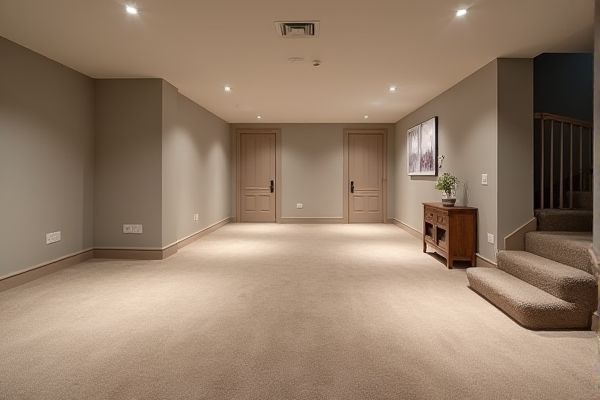
Choosing between a finished basement and an unfinished basement impacts your home's functionality and value, as finished basements offer insulated walls, flooring, and defined spaces for living or recreation, while unfinished ones provide raw, flexible space for storage or future projects. Explore the pros and cons of each option to determine which best suits Your needs and lifestyle by reading the full article.
Table of Comparison
| Aspect | Finished Basement | Unfinished Basement |
|---|---|---|
| Cost | Higher initial investment ($20-$50/sq ft) | Lower initial investment |
| Functionality | Usable living space (bedroom, office, recreation) | Storage, utility area, or future renovation potential |
| Value Addition | Increases home resale value significantly | Minimal impact on resale value |
| Comfort | Insulated, climate controlled, well-lit | Cold, damp, minimal lighting and insulation |
| Maintenance | Requires regular upkeep (cleaning, repairs) | Lower maintenance, easier to detect issues |
| Finishing Time | Longer (weeks to months) | Immediate usability |
What Is a Finished Basement?
A finished basement is a fully developed space with completed walls, flooring, lighting, and often heating, making it suitable for living or recreational use. It typically includes insulated walls, drywall, paint, and may feature amenities like built-in storage, bathrooms, or additional bedrooms. Your finished basement adds valuable square footage and functionality, enhancing home comfort and resale value.
What Defines an Unfinished Basement?
An unfinished basement is characterized by exposed concrete walls, floors without carpeting or other final surfaces, and open ceilings revealing ductwork and wiring. Unlike finished basements, it lacks drywall, insulation, and designed living spaces, making it primarily suitable for storage or utility purposes. Understanding what defines an unfinished basement helps you decide whether to invest in renovations or maintain it as a functional area for household systems.
Key Differences: Finished vs Unfinished Basements
Finished basements offer insulated walls, flooring, and ceiling treatments that transform the space into livable areas like bedrooms or entertainment rooms, significantly increasing your home's usable square footage and resale value. Unfinished basements typically have exposed concrete floors, walls, and overhead joists, providing raw, flexible space primarily for storage or utility purposes but lacking the comfort and aesthetics of finished areas. Choosing between a finished vs unfinished basement depends on your needs for functionality, budget constraints, and long-term home improvement goals.
Cost Comparison: Finished vs Unfinished Basement
Finished basements typically cost between $30 to $75 per square foot, depending on materials and design, while unfinished basements generally incur expenses around $10 to $15 per square foot for basic sealing and flooring. You can expect a finished basement to increase your home's value and usability, but the upfront investment is significantly higher compared to an unfinished space. Choosing between the two depends largely on your budget and whether you prioritize immediate functionality or potential long-term home equity.
Pros and Cons of a Finished Basement
A finished basement enhances your home's living space by providing a comfortable area for recreation, extra bedrooms, or a home office, increasing property value and energy efficiency. It requires an initial investment for materials, labor, and permits, with potential moisture issues demanding proper waterproofing to prevent damage. Your decision should weigh the benefits of added functionality and resale appeal against the costs and maintenance involved in completing the basement.
Pros and Cons of an Unfinished Basement
An unfinished basement offers the advantage of lower initial costs and greater flexibility for future customization, allowing homeowners to tailor the space to their needs over time. However, it often lacks finished flooring, insulation, and walls, which can result in lower energy efficiency and reduced livability compared to a finished basement. Moisture issues and limited usability without proper finishing are common drawbacks, making it less suitable for immediate use as living or storage space.
Impact on Home Value: Finished vs Unfinished Basement
A finished basement significantly increases home value by providing additional living space, such as bedrooms, home offices, or entertainment areas, appealing to buyers seeking usable square footage. Unfinished basements are often viewed as storage or utility spaces, limiting their contribution to overall home appraisals and marketability. Your investment in finishing a basement typically yields a higher return by enhancing functionality and aesthetic appeal, making the property more attractive and valuable.
Common Uses for Each Basement Type
Finished basements commonly serve as additional living spaces such as family rooms, home offices, or guest bedrooms, enhancing overall home functionality and comfort. Unfinished basements are typically used for storage, laundry areas, or utility rooms, offering flexibility for future customization and cost-effective space management. Homeowners often choose finished basements for increased property value and usability, while unfinished ones provide practical, low-maintenance solutions.
Maintenance and Upkeep Considerations
Finished basements require regular cleaning, HVAC maintenance, and potential repairs to drywall, flooring, and fixtures to keep the space comfortable and visually appealing. Unfinished basements demand moisture control, occasional pest prevention, and routine inspection of exposed pipes and foundation walls to prevent damage or mold growth. Both types benefit from proper ventilation and waterproofing to minimize maintenance issues over time.
Which Basement Option Is Right for You?
Choosing between a finished basement and an unfinished basement depends on your budget, intended use, and long-term value goals. Finished basements offer immediate living space with higher resale value and comfort, while unfinished basements provide flexibility for future customization and lower upfront costs. Homeowners seeking ready-to-use areas often prefer finished basements, whereas those prioritizing cost savings and potential DIY projects may opt for unfinished spaces.
 homyna.com
homyna.com